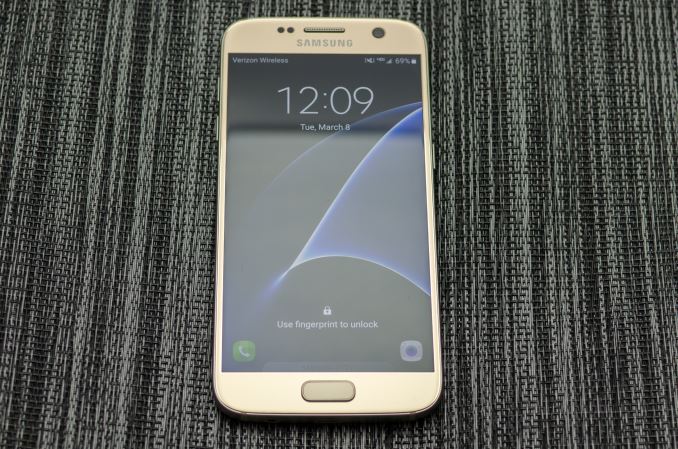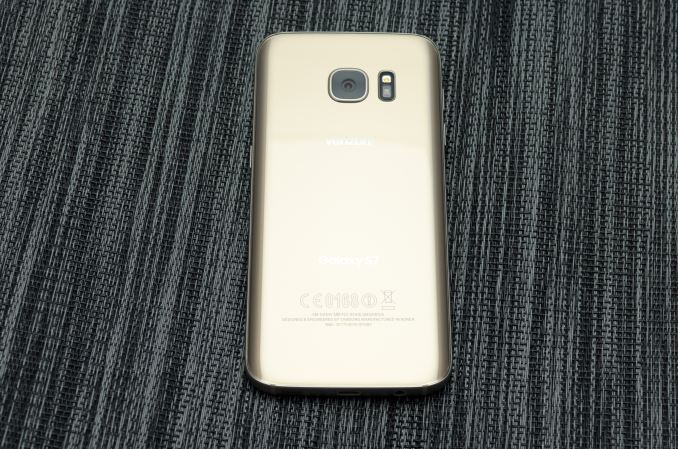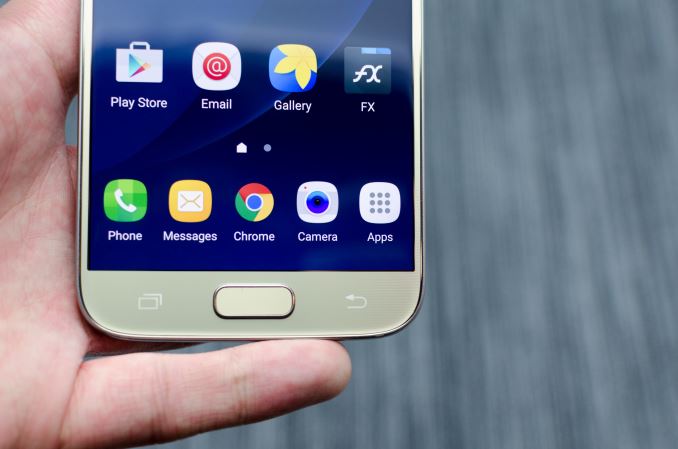The Samsung Galaxy S7 & S7 Edge Review, Part 1
by Joshua Ho on March 8, 2016 9:00 AM ESTInitial Conclusions
Even though we’re just barely scratching the surface of what we can test, the results we already have show quite a bit about the Samsung Galaxy S7. The Galaxy S line remains one of the most popular Android smartphones, and if history is any indication we can get a pretty good idea about what to expect for 2016 just by looking at the Galaxy S7 and S7 edge.
The first place we can start is design, and here we can see that the Galaxy S7 is decidedly an evolution of the Galaxy S6’s ID. However, pretty much every sharp edge has been rounded out to make the device more comfortable in the hand. The device has also been thickened in order to handle the larger battery and reduce the apparent z-height of the camera. The display size of the Galaxy S7 (non-edge) stays at 5.1 inches, and given how long Samsung has stuck to this display size it’s likely that they will be staying at this size for quite some time for their flagship.
In general, it feels like the industry has settled upon a display size somewhere between 5 to 5.5 inches for their flagship devices as going further probably won’t make a lot of sense for ergonomic reasons. I suspect Samsung and many other Android OEMs are settling into an Apple-like 2 year cadence for industrial and material design as replacement cycles lengthen, especially in the United States where subsidized phones have been almost entirely eliminated.
Meanwhile, though we haven’t had the time to run our full suite of battery life benchmarks, the data that we do have is quite interesting. At the very least, it looks like the Galaxy S7 will be a solid upgrade for those coming from the Galaxy S6 and earlier with a 15% bump in battery life or so. Anyone using a phone with an SoC not on a FinFET node will see even bigger gains to battery life, which is impressive to say the least. If you have any device with a Snapdragon 810 or 808 SoC, you’re definitely going to see major gains if you move to any device with a SoC fabricated on a FinFET node.
In terms of SoC performance, the Snapdragon 820 doesn't disappoint. In the time since testing the MDP it seems that between Qualcomm, Samsung, and Google, the trio has finally been able to optimize Snapdragon 820 for Chrome, so performance there is quite acceptable now and a pretty solid uplift over something like the Exynos 7420 or Snapdragon 810. GPU performance is also pretty much right where the Snapdragon 820 MDP was, so performance should be a good step above the A9's GT7600 GPU. Of course, we have yet to consider the power efficiency or sustainability of this performance, but turbo/overdrive performance is always relevant in the mobile space considering just how bursty almost every mobile workload is. It's pretty safe to say that Qualcomm has at least regained their footing in the SoC space, and with future SoCs they may well come to dominate the high end for performance and power once again. For now, it's looking like the race between Exynos 8890, Snapdragon 820, and Kirin 950 will be quite close.
For storage performance, to some extent it seems that the performance gains are relatively small, as the UFS 2.0 storage solutions on the Galaxy S6 and S7 are relatively similar. It’s interesting to see here that despite the now-mandatory use of FDE, the delta in performance between the Galaxy S6 and S7 in storage performance doesn’t seem to exist. This is welcome news as it wasn’t all that long ago that FDE for Android had a noticeable effect on storage performance.
On the display side, again we can see that the Galaxy S7 has a relatively similar display to the Galaxy S6. Calibration should be relatively good across the board, and AMOLED retains all of its traditional advantages including high contrast, support for wide color gamuts, low transition time, and improved power efficiency at lower average picture levels. Peak brightness is the only noticeable area where things seem to change, but I suspect that this will vary noticeably depending upon the unit. The one issue that I continue to notice here is that the edge display on the Galaxy S7 edge has a green tint at the edges, likely due to the diamond PenTile subpixel arrangement.
On the software side, Samsung’s TouchWiz UI continues to be more of the same when compared to the Galaxy Note5. The edge features continue to be somewhat interesting, but I continue to find myself thinking that there would be no difference if the same feature was implemented on the non-edge variant. Thankfully, the lag that I noticed last month in my initial hands-on time with the device seems to just have been a function of pre-release software, as the Galaxy S7 is relatively performant here. Although I’m not sure I’d go as far as to say that the Galaxy S7 is entirely free of lag. I suspect that Samsung has to balance power efficiency and responsiveness to some extent here, as while devices like the Nexus 5 can feel incredibly smooth and responsive there are very real knock-on effects in terms of practical battery life.
I’m also looking forward to testing features like Samsung Pay that are finally being deployed to the extent that I can use my personal credit card with Samsung Pay on my phone. However, out of the box TouchWiz still has some issues with an overly-neon theme, and in general things like Always-On Display already feel like they aren’t quite executed as well as they should be. I also noticed that the fingerprint scanner performance is strongly influenced by initial setup if I didn’t scan some areas on initial setup they never seemed to work very well unless I retrained the finger.
As for making a choice between the Galaxy S7 edge and Galaxy S7, there basically aren't any outside of size for the most part. There is the edge display, but by and large it feels like that's more of an aesthetic choice than a functional one. As we have seen you do get better battery life in the Galaxy S7 edge, but I don't feel like it makes sense to cross-shop the two. If you want one-handed usability, the Galaxy S7 is the only choice that makes sense. If you want a phablet, the Galaxy S7 edge is the only choice that makes sense.
Overall, I think the Galaxy S7 is looking to be one of the better devices of the year. Of course, there’s still a lot more to test, but the initial indications are already looking quite good. If you absolutely want the Galaxy S7 now, I don’t think there will be any major showstoppers present in this phone. However, if you’re looking to buy the best phone possible available this year I think it’s still too early to say where the chips will fall as Samsung's eager competitors have their own flagship phones right around the corner.














202 Comments
View All Comments
buxe2quec - Tuesday, March 8, 2016 - link
And I'm still wondering... how is it possible that years after various websited emphasized the better alignment and design of the connectors and perforations of the iPhone, Galaxies are still aligning them with no care at all? check that top side with the slots and holes thrown there randomly and that bottom side with the four holes (or groups thereof) aligned in FOUR different ways.But hey at least Apple supporters won't say they are copying everything...
Dobson123 - Tuesday, March 8, 2016 - link
I couldn't care less.name99 - Tuesday, March 8, 2016 - link
Fair enough. But don't then complain that it's "unfair" when Apple sucks up 80% of the profits in this sector. It's attention to details (ALL details) that allows a company to charge more...lilmoe - Tuesday, March 8, 2016 - link
Attention to detail hardly has anything to do with the port alignment at the bottom of the phone, and more so with the antenna bands on the back and the cheap choice of aluminum alloys in previous models (changed only after "bending" to public pressure, pun intended).A nice finish =/= quality. A polished piece of cheap glass looks better than a rough diamond.
Most of Apple's attention to detail goes to media, perception, image, supply chain, and money making business models. Well, at least more so than their attention to hardware.
You have good points here and there, but your fanboyish attitude ruins the good parts...
theduckofdeath - Tuesday, March 8, 2016 - link
Exactly. And there is a pretty good reason why the SD/SIM slot is on the side on the top. It can't be in the same location as the camera's. Apple have displaced the camera to a corner, that's not very symmetric in my eyes. And like you, I've never been a fan of those plastic separators on the back on all-metal phones.End of the day, manufactures are always doing deliberate design differentiations to make sure their hardware is distinguishable from a distance. Most people can easily identify a Samsung phone when someone's using it, simply because they've stuck to the same camera design/location since the Galaxy S2.
tipoo - Tuesday, March 8, 2016 - link
I think you mean this?http://www.imore.com/difference-apple-samsung-indu...
That was about the GS6 and only just started making its rounds, after Samsung finally tried to make nicer designs. I mean, I agree with you, it's such a bizarre miss, but when you say "years and years", it's really, "year", or less.
grayson_carr - Wednesday, March 9, 2016 - link
Well if the Galaxy phones had bezels the size of Texas like the iPhones, I'm sure they could align the ports better because they'd have more room to work with.syxbit - Tuesday, March 8, 2016 - link
"While not quite going from zero to hero, Qualcomm has come close, and that definitely deserves some credit."I disagree. Giving them credit because of the large improvement over the awful SD810 doesn't make sense.
Instead of a comparison to last years garbage, give them credit for how SD820 performs compared to todays best SoCs. It turns out SD820 isn't really leading that much. It's mostly still behind a year old Apple chip.
whiteiphoneproblems - Tuesday, March 8, 2016 - link
"Always-On Display is nice to have, but for some reason it only polls the ambient light sensor, so the display won’t actually turn off in your pocket."This is strange and disappointing. I wonder why it does not use the proximity sensor.
whiteiphoneproblems - Tuesday, March 8, 2016 - link
...and as a stab at answering my own question: I assume constantly polling the prox sensor would cause a greater battery hit than simply leaving the display on all the time (including in pocket)?Would be interesting to chart battery life with AOD on vs. off (in some kind of controlled way, of course).